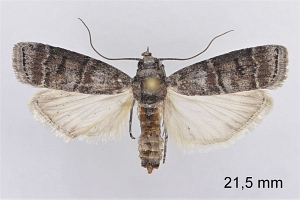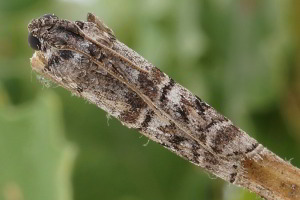Länder:

 +6Kontinente:EUAS
+6Kontinente:EUAS


 +6Kontinente:EUAS
+6Kontinente:EUASNeues Layout der Navigation (Beta Test)
LebendfotosDiagnoseGenitalienWeitere InformationenTaxonomie und FaunistikPublikationsdatum der ErstbeschreibungLiteratur
2. Diagnose
2.1. Männchen
1: ♂, Mazedonien, Umgebung Prilep, hügeliges Offenland, 620 m, am Licht, 23. August 2015 (leg. & Foto: Friedmar Graf), det. František SlamkaForum
2.2. Weibchen
1: ♀, Griechenland, Chalkidiki, Waldweg bei Ierissos, 228 m, 40.381438, 23.831127, 1. September 2019, am Licht (leg., det. & fot.: Friedmar Graf)Forum
2.3. Genitalien
2.3.1. Männchen
1-2: Genitalpräparat des als Lebendfalter 1-3 und Diagnosebild 1 abgebildeten ♂, Mazedonien, Umgebung Prilep, hügeliges Offenland, 620 m, am Licht, 23. August 2015 (leg. & Foto: Friedmar Graf), det. František SlamkaForum
2.4. Erstbeschreibung
1: Ragonot (1887: 228) [nach Copyright-freiem Scan auf www.biodiversitylibrary.org]
3. Weitere Informationen
3.1. Taxonomie und Faunistik
Plant (2016) formuliert für Bulgarien sehr schön, was ganz Europa betrifft: "Phycita nephodeella Ragonot, 1887, reported from Italy and the former Yugoslavia by Karsholt & Razowski, 1996) and P. pedisignella (Ragonot, 1887) stated by the same authors to be present in Greece and the former Yugoslavia are still something of a mystery and so far it has been impossible to locate any material of either species."
(Autor: Erwin Rennwald)
3.2. Publikationsdatum der Erstbeschreibung
28. Dezember 1887 (Begründung siehe unter Acrobasis niveicinctella).
3.3. Literatur
- Plant, C. W. (2016): An Annotated Systematic, Synonymic and Distributional Checklist of the Pyraloidea of Bulgaria (Lepidoptera, Crambidae & Pyralidae). — Neue Entomologische Nachrichten 72: 1-231.
- Erstbeschreibung: Ragonot, E.-L. (1887): Diagnoses d'espèces nouvelles de Phycitidae d'Europe et des pays limitrophes. — Annales de la Société entomologique de France. 6e série 7 (3): 225-260. Paris.


















